What Tofu Coagulant should you use for homemade tofu? I put traditional tofu coagulants (gypsum, nigari) to the test against grocery store ingredients (lemon juice, two vinegars, and epsom salts) to see which coagulant makes the best tofu at home! Will they change taste or texture? Read on!
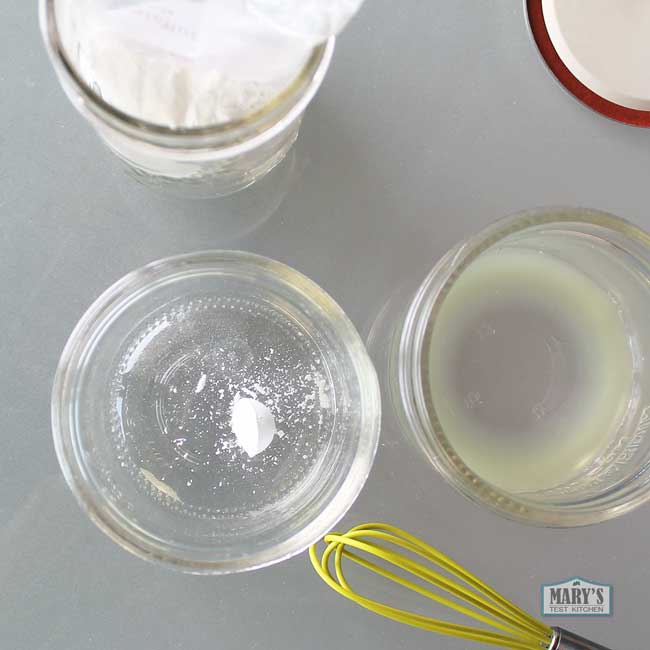
Quick! What are the Measurements for Different Tofu Coagulants
How much coagulant should you use to make your homemade tofu? In case you’re here just to find out what measurements to use for each coagulant, these are the measurements I used for about 1 liter (4 cups 1/2 oz) soymilk made from 250g (1 1/3 cups) dried soybeans.
Gypsum (calcium sulfate)
Use 1.5 teaspoons powdered gypsum in 1/2 cup of room temperature water. Stir the mixture just before adding to your hot soymilk.
Spoiler Alert: This one’s still my favorite tofu coagulant. Cheap, accessible (on Amazon), and tasteless!
Liquid Nigari
Because concentrations may vary, check the package instructions. Or try 2 tsp liquid nigari in 1/2 cup room temperature water. This is the quality I used when using this Liquid Nigari.
Epsom Salt (magnesium sulfate)
Be sure to use only Epsom salt that is labelled for internal use. Use 1.5 teaspoons Epsom salt dissolved into 1/2 cup room temperature water.
Lemon Juice
Natural juice from lemons may vary in acidity so I use bottled for consistency. Regardless of your source, please use this measurement as a starting guide. You might need a little more. I used 2 tablespoons bottled lemon juice mixed with 1/2 cup room temperature water.
Apple Cider Vinegar or White Vinegar
Use 2 tablespoons of Apple Cider Vinegar or White Vinegar in 1/2 cup room temperature water.
Video: Which Tofu Coagulant Makes THE BEST Tofu?
Why test different coagulants?
Based on your comments and my curiosity, this post seeks to clarify:
- What are these tofu coagulants made of?
- How do the acids work versus mineral salts?
- Do they make different textures?
- Does the coagulant affect the size of the curds?
- How does the finished tofu taste?
With these answers, you can decide which coagulant to buy, or if you can use something already in your cupboards! Plus, maybe you’ll want a different coagulant depending on what you’ll be using your homemade tofu for.
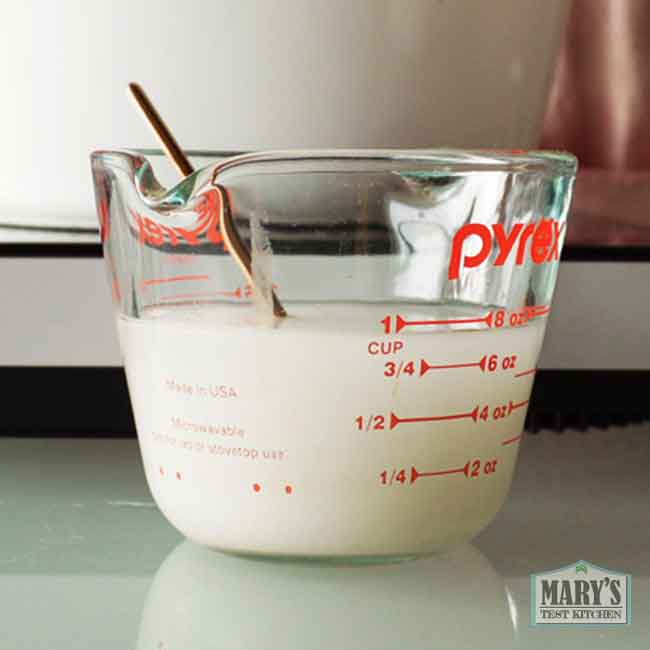
The Tofu Coagulants (salt and acid-based)
Traditional tofu-making coagulants include gypsum and nigari. But you can also make tofu with grocery store ingredients like lemon juice, vinegar and Epsom salts.
Gypsum – aka calcium sulfate, a tasteless naturally occurring mineral salt traditionally used in tofu-making, especially Chinese tofu.
Nigari – the name for this mineral salt comes from the word for “bitter” in Japanese. Nigari is the liquid leftover after concentrating seawater and removing the sea salt (sodium chloride) from it. This leftover brine is mainly magnesium sulfate and can be sold as a liquid or flakes/powder.
Lemon Juice – with a pH between 2.4 and 2.6, I use bottled lemon juice to avoid natural variations in fresh lemons.
Apple Cider Vinegar – with pH 2.4, this acid has a fermented apple flavor. It’s really common in the vegan / health and wellness sphere which is why it’s our first vinegar to test.
White Vinegar – same 2.4 pH as ACV, this acid is in every grocery store and usually very cheap. Of course we have to try it out too!
Epsom Salt – aka magnesium sulfate, can be found at pharmacies. However, you don’t want to be using regular bath salts (they are “for external use only”). It comes in crystals and should act the same as nigari…but will it?
Other Coagulants (not tested today)
GDL – glucono delta lactone – is commonly used by commercial tofu manufacturers in conjunction with calcium sulfate or magnesium chloride. Unfortunately, I could not get it in time for this video. Plus it’s kind of expensive.
Lime juice – reported by commenters to work. But it’s similar enough to lemons so I believed the test would be redundant.
Other mineral salts and acids available at grocery stores- would be interesting to test and taste the differences. So many ingredients, so little time!
The Experiment
To make it an fair experiment, I used the same process from beans to tofu for each of the coagulants. This is a Chinese-style traditional tofu-making method wherein soy milk is coagulated and the soy curds are pressed into a block to make high protein, bouncy tofu.
All of the conditions and timings were made to be as consistent as possible in a home kitchen (and within a real-life!). Plus, all of the non-GMO, Canada-grown soybeans were bought at the same time and from the same brand.
Since I have only two of my favorite identical tofu presses, I conducted the same process 3 times in succession in order to test all 6 coagulants.
1. The Soymilk
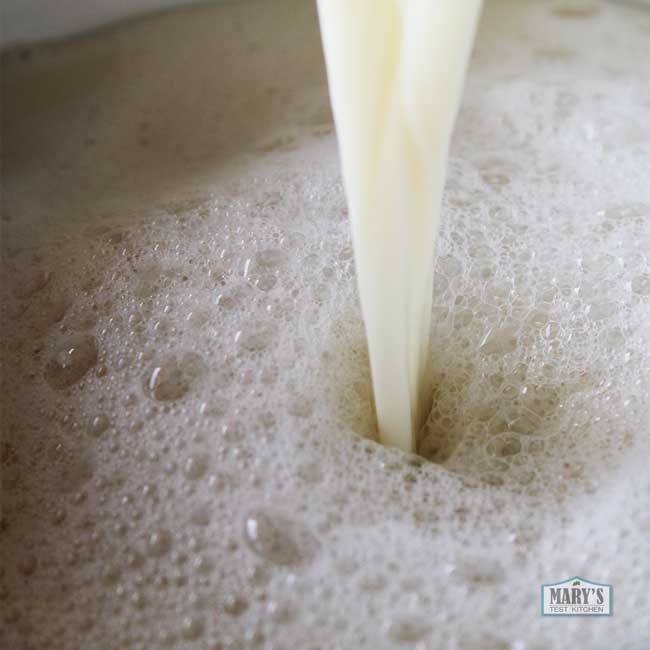
A. Cold soaked 500g dried soybeans (for 250g of beans per tofu block) overnight in the fridge (about 12-14 hours). Then drained and picked out any bad beans.
B. Divided the drained beans into two equal portions. Then blended each portion with 1180 ml water on the highest speed in Vitamix E10 for 25 seconds. Put the puree through a nut milk bag and strained as much as possible.
C. After combining the milk from both portions into the cooking pot, it measured about 2325ml (all three batches were consistent within 10ml). Then, I skimmed off the foam, then cooked milk while stirring continuously. It was heated to a boil, then simmered gently 10 minutes to cook through.
D. Cooked milk was measured, then divided into two equal portions. This time, the measurements of the cooked milk varied more:
- 1st batch – 1976 ml,
- 2nd batch – 2217 ml,
- 3rd batch – 1993ml
Clearly, there was less evaporation from the 2nd batch. However, since it was still made from the same amount of soybeans, I didn’t believe the yield would be affected. However, to make this more equal, I could’ve added water to each cooked batch of soymilk to make it the same concentration.
2. Adding the Coagulants
Each coagulant mixture was prepared ahead of time. Then each portion of soymilk is heated to 180°F and coagulant mixture stirred in. Checked that temperature was around 165°F afterwards. The heat was turned off and soymilk was covered with a lid to rest on the warm stovetop for 15 minutes.
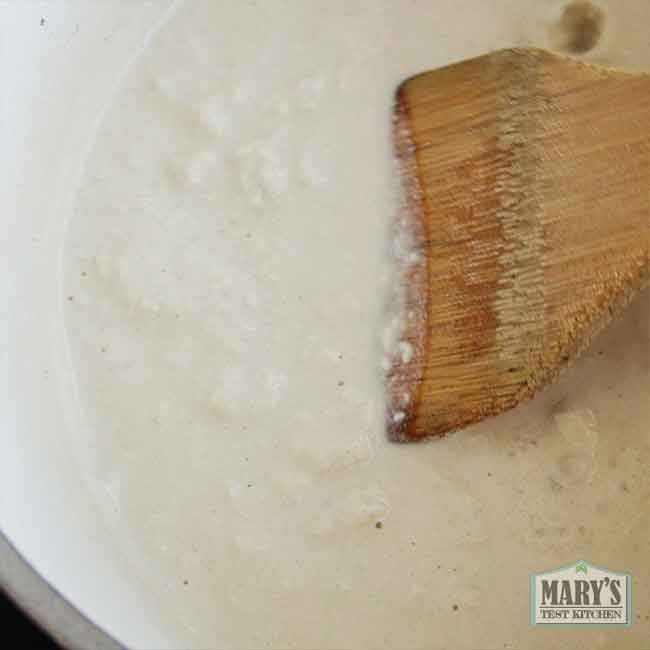
3. Pressing the Curds
After the 15 minute waiting time, I uncovered the curds and tasted a bit of the fresh curds. Then I transferred the curds to a cheesecloth-lined tofu press. I wrapped the curds up, added the pressing lid, and drained off the soy whey. Then refrigerated the whole thing overnight (about 20 hours).
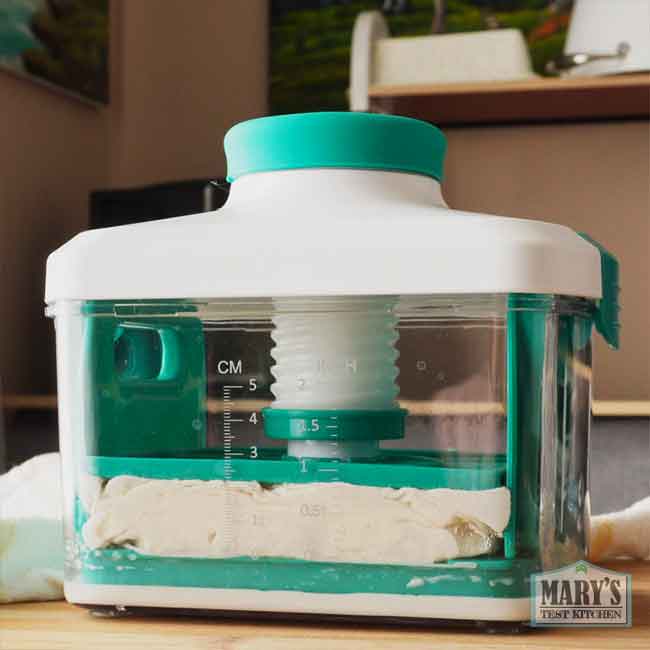
4. Revealing the Tofu
Lastly, the tofu is revealed! We looked at the outside texture, cut inside, texture when broken by hand, and taste.
How Different Coagulants Affect Homemade Tofu – Results!
The most surprising result was that tofu made from different coagulants all looked very similar! The fresh curds all looked fairly similar with very small degrees of variance. The pressed tofu curds were almost indistinguishable. The vinegar-based blocked looked a bit more bumpy on the outside. But all the blocks came out to be Firm Tofu, and all were a consistent firmness to the touch.
I sliced a piece off each block and the cross-sections were practically identical.
I broke pieces off by hand to see if that revealed any differences in the structure. Most of them seemed very similar while the Epsom Salt variety was a bit finer.
The main difference? FLAVOR! And to a lesser degree, mouthfeel/chew.
Tofu coagulated with Gypsum
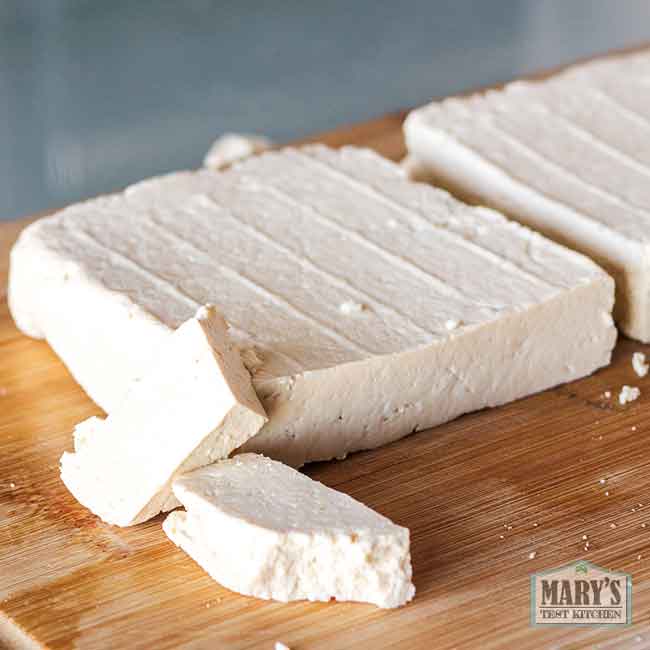
The tofu made with gypsum was the best tasting! The fresh, unpressed curds were mild tasting. After pressing, the tofu was firm but bouncy. The taste was mild yet savory. And the chew and mouthfeel was meaty and satisfying. This is one tofu that can be eaten fresh without any seasonings and it’s still good.
Tofu coagulated with Nigari
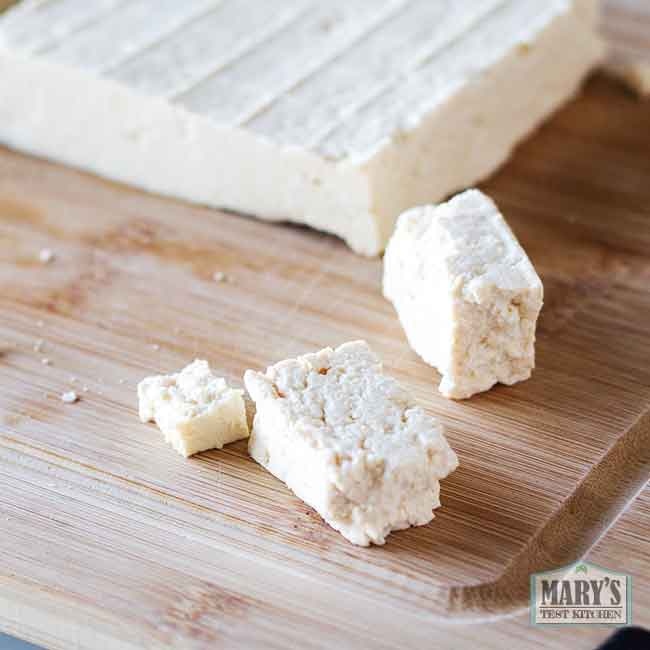
The fresh unpressed curds were bitter. But this is expected! Nigari is bitter but after pressing, the bitterness was gone. However, I found there was a slight off-flavor that was off-putting enough that I would not eat it fresh on it’s own. It was almost metallic (but not quite), and almost sour (but really not sour).
That said, it was such a mild flavour that it was easily covered up when I cooked this tofu with basic seasonings. I would not let this flavor discourage you from using nigari as a coagulant if it’s available to you.
I was surprised that the texture and mouthfeel was the same as the gypsum tofu.
Tofu coagulated with Lemon Juice
With the same outside appearance of its predecessors, I was not surprised to see the cross section to also be indistinguishable. While the fresh curds did taste of lemon and were slightly sour, the finished tofu was not sour at all. The distinct lemon flavor disappeared but became bright and delicious!
This tofu had a slight “stick-to-your-teeth” quality that all the acid-based tofu’s seemed to have in varying degrees. This was not unpleasant, but actually satisfying in a meaty sort of way. The curds seemed a bit more pronounced, as if the proteins were bound together more tightly.
Photo: Tofu made with lemon juice is on the left hand side; tofu made with apple cider vinegar on the right.
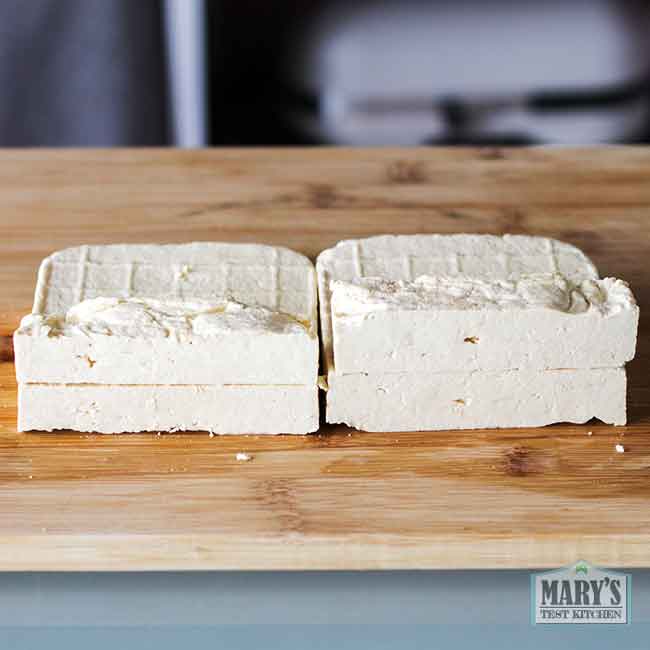
Tofu coagulated with Apple Cider Vinegar
This was the similar to the Lemon Juice Tofu, but with the added flavor of fermented apple. However, it’s a mild flavor and could be used to your advantage! You could use it in a tofu dish that would be enhanced by a slight fruity flavour.
While the curds did not appear bigger to the eye, when chewing, this tofu feels meatier; as if the individual curds were larger.
Tofu coagulated with White Vinegar
Similar to the Apple Cider Vinegar Tofu, the white vinegar tofu feels meaty. There is just the tiniest hint of a vinegar flavor but without being sour.
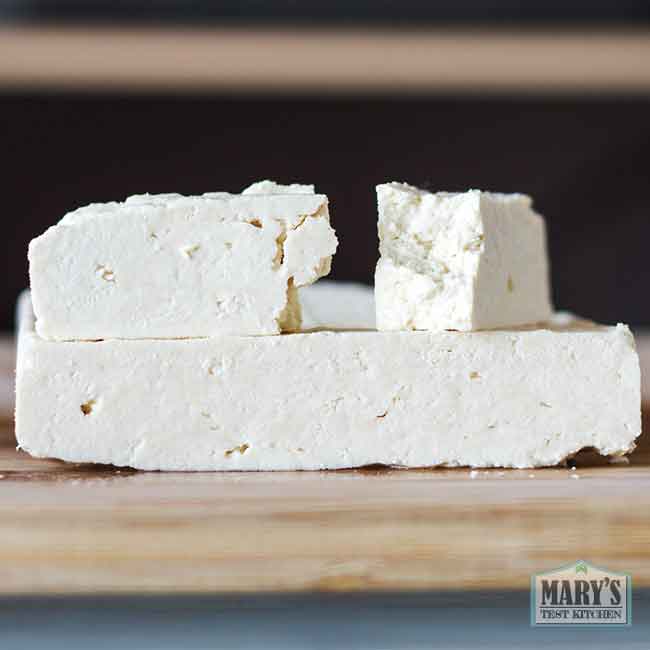
Tofu coagulated with Epsom Salt
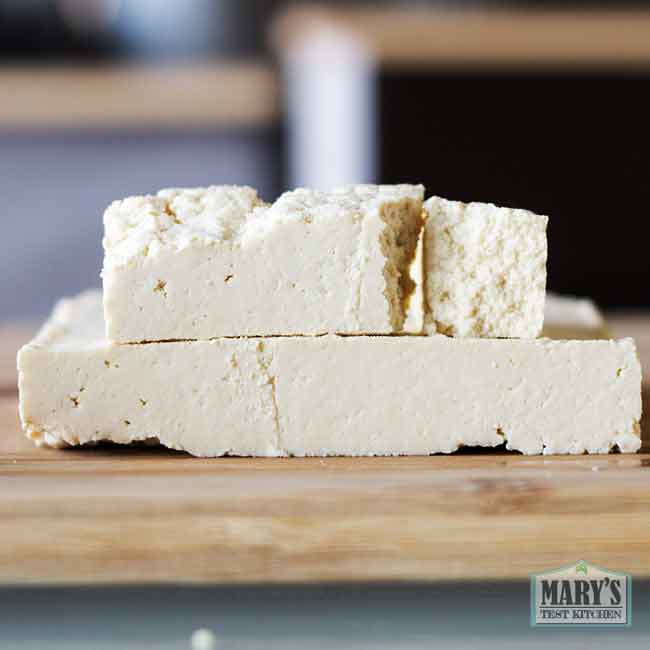
These made the only fresh curds that made me feel like my whole body was rejecting them; strangely sweet and weird. However, after pressing the curds, the finished tofu was okay! The flavor became only slightly sweet. I don’t prefer this taste plain but it was totally fine after cooking.
The visually, the block looked the same, the cross section looked the same. The broken off texture looked a bit finer. Biting into it, the mouthfeel is finer as well.
I felt myself comparing the texture to chicken breast while the acid-tofu’s felt more “beefy”.
Note about the different finished tofu weights
This is one difference which I believe to be a flaw of the experiment and not something we can conclude to be the effect of the coagulants, was the weight variance in the tofu yield. Since I had two “identical” presses, I made these tofu’s in pairs. Each pair had a difference in weight of about 30 grams.
First pair of finished tofu (after a day in storage with water because I forgot to weight it at the reveal):
- Gypsum: 375g
- Nigari: 343g
Second pair of finished tofu:
- Lemon Juice: 286g
- Apple Cider Vinegar: 317g
Third pair of finished tofu:
- White Vinegar: 272g
- Epsom Salt: 313g
This difference may be explained by the fact that I’ve had one press longer than the other. One of the lid springs may just be a bit more worn out. Therefore, one pressing lid could’ve applied a bit less pressure than the other.
Personally, I was fairly surprised at the results! I have made tofu with all of these coagulants before but with slightly different processes or conditions. In fact, I was convinced each coagulant would make more of a difference. But making them side-by-side, one after the other, showed me otherwise.
Which tofu coagulant is the best?
So which tofu coagulant should you use? I think ALL OF THEM! Whichever tofu coagulant is accessible to you is perfect. They all make good quality tofu, yield a similar amount, and can be used in your cooking without negative effects.
While some have a slight flavor to them, this can easily be removed through boiling in water or covered up with even a small amount of seasonings.
My personal favorite remains gypsum (calcium sulfate) as it is cheap, easy to get (from Amazon or beer-making supply stores), and is completely tasteless.
But if I was in pinch and I only had vinegar or lemon juice on hand, I would not hesitate. Epsom salts are a bit less accessible but if it was all I had, I wouldn’t be mad.
Were you surprised by the results? Based on this, which coagulant do you think is the best for you? Please let me know your thoughts in the comments below.
I hope this post was helpful! Thanks for reading!


Hi, very great to see tofu making process. But i am in south india, i prefer to buy tofu from shopping. So please which type if tofu is best as i mentioned the shopping link here to look out by you to suggest me, which tofu ingredient used is good for me as i am type-2 diabetes, and also for good for heart?
https://www.maindish.in/product/morinaga-silken-tofu-firm/
(Ingredients) : Soy milk (Filtered Water And Soybeans), Soy Protein Isolate, Glucono -Delta – Lactone, Calcium Chloride
https://www.maindish.in/product/tofu-voila-silken-tofu-firm-300g/
Ingredients: Water, Soybeans, Soy Protein Isolate, Coagulant: Magnesium Chloride
Some other online soya tofu lroducts mentions ingredients as water, calcium chloride and some mention as purified water, salt, coagulant
Very confused i am , which is best to buy?!
So please help me and requesting you to lokk into above mentioned websites of the ingredients mentioned and tell me which is good to buy ? Cud u help me ? I have my father taking blood thinner tablets and has BP, diabetes, i am.considering to buy tofu to give small amount of tofu by eating directly without mixing with food preparation. Just like eating directly by one or two pieces daily is good or not??
Hi John,
You might want to watch my guide on tofu to see all the different types: https://www.youtube.com/watch?v=j2OwDXgbQRk
The two types of tofu you’ve linked are both silken tofu. You don’t need to over-think on these ingredients; they are all good, common ingredients for tofu.